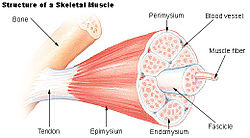|
The term [muscle] arises from the Latin word [musculus] which derives from the Latin term [mus] meaning "mouse". We can only guess that, just as today, Roman fathers would show their biceps and forearm muscles to their children and tried to make them believe a mouse had gotten under their skin!. The root term for muscle is [-my-]. The corresponding combining form is [-myo-]. There are three types of muscle in the human body: • Skeletal muscle: it is typical of muscles related to bones (skeletal) and they are voluntary. |
 |
| Skeletal and cardiac muscles have distinct striations visible under a microscope.
Muscles are formed by subunits, each one surrounded by a named membrane. One of the suffixes that means layer or membrane is [-sium]: • Epimysium: Epi=outer; my=muscle; sium=membrane. The outer or external membrane (layer) of a muscle Original image courtesy of Wikipedia. Click on the image for a larger version. |
|
| Back to MTD Main Page | Subscribe to MTD |